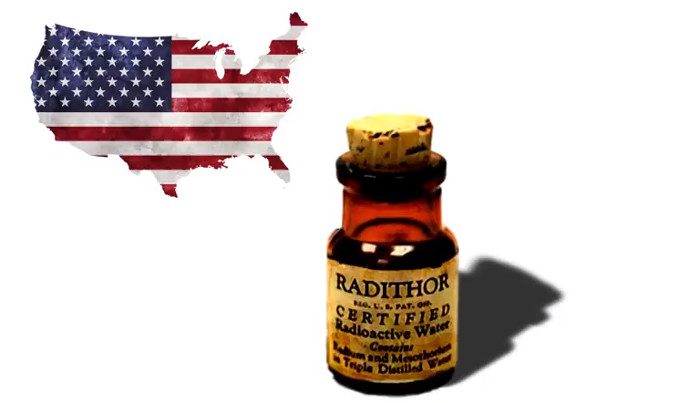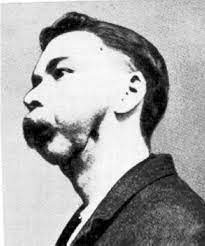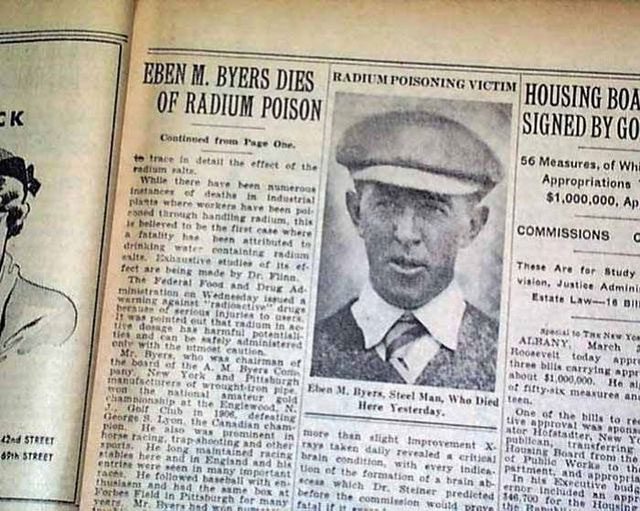Many wealthy Americans were once enamored with Radithor, a radioactive energy drink containing the highly radioactive element radium, in the early 20th century.
According to Oddity Central, when we learn about the current information on radioactive elements and their effects on the human body, most of us would hesitate to even touch, let alone drink, a bottle of water containing radium. However, in the early 20th century, a radioactive energy drink was marketed as a “miracle cure” and became an intense craving among the elite.
Radithor and other radioactive elixirs were sold as harmless remedies that could eliminate fatigue and cure all kinds of ailments, including cancer. Unfortunately, the reality was that they slowly killed those who believed in them.
Radithor, a distilled water containing two radioactive substances – radium and mesothorium – is perhaps the most famous example of radioactive water, possibly because it is the only substance linked to the deaths of many people. It was sold in small 60ml bottles and guaranteed to contain at least 1 microcurie of both Ra-226 and Ra-228.
The manufacturer of Radithor, Bailey Radium Laboratories in East Orange, New Jersey, claimed that this expensive “tonic” could cure dozens of ailments, including anorexia, hysteria, and insomnia. However, this was not true, as the fate of Radithor’s most enthusiastic consumers clearly demonstrated.

Image of the radioactive water bottle Radithor.
Eben Byers, a wealthy American industrialist and socialite, began using Radithor on his doctor’s advice. He had injured his arm while attending a train event after the Harvard-Yale football game. He was prescribed Radithor to aid in his recovery. In December 1927, he started drinking about 3 bottles of Radithor each day and continued to do so for the next few years.
Believing that Radithor deserved recognition for the energy and health it provided, Eben Byers could not help but praise this “tonic.” He gifted it to his friends and business partners, assuring them that his girlfriend always carried Radithor with her and that his racehorses also drank it. It is believed that Byers consumed a staggering 1,400 bottles of Radithor by 1930, when his teeth began to fall out.
By the time Eben Byers turned 50, the “energy drink” was beginning to harm his body. It started with his teeth, but that was just the beginning of the end. In 1931, when Robert Hiner Winn – a lawyer for the Federal Trade Commission, was sent to interview Byers as part of the documentation against the Radithor manufacturer – he was horrified by the condition of this businessman.
According to Winn’s report, when Eben Byers opened the door of his mansion to welcome him inside, his entire lower jaw and chin had disappeared, rotting due to radium poisoning. The 51-year-old man had only two teeth protruding from a piece of bone beneath his nose, and there were even holes in his skull exposing his brain.

Eben Byers with a surgically altered jaw in 1932. (Photo: Imgur)
In a 1932 Time magazine publication, Winn wrote: “Younger by a few years and mentally alert, but he could hardly speak. His head was wrapped in bandages. This businessman had undergone two consecutive surgeries, during which his entire upper jaw, except for two front teeth, and most of his lower jaw were removed. All the remaining bone tissue in his body was gradually being destroyed, and holes were forming in Byers’ skull.”
Eben Byers passed away in 1932, and his death marked the beginning of the end for Radithor. The account of this industrialist regarding the tonic and the subsequent lawsuit by the Federal Trade Commission put an end to Radithor. Yet, despite its downfall, this radioactive drink still garnered support, even from medical professionals. However, the demand to “cease production and destroy Radithor” from authorities ultimately halted the production of this radioactive beverage.
Radithor was produced from 1918 to 1928. Besides the death of Eben Byers, the extent of the damage it caused to consumers largely remains unclear. Experts believe that due to its status as an expensive “cure,” the damage it could inflict was limited, as only wealthy individuals could afford to consume it in large quantities.

The death of Eben Byers was reported in the New Jersey newspaper. (Photo: Wow Science).
When Eben Byers died, he was laid to rest in a lead-lined coffin to prevent radiation from escaping his bones. By 1965, when a scientist exhumed his remains to measure radiation levels, they were astonished by their findings.
Robley Evans, an expert in measuring and modeling radiation in the human body, estimated that Byers’ bones had a radioactivity level of about 100,000 becquerels at the time of burial. Since radium has a half-life of 1,600 years, the scientist estimated that the remains exhumed still had the same level of radioactivity as before. However, the remaining skeleton actually had a total radioactivity of 225,000 becquerels.
The reason for the significant discrepancy in Evans’ radiation estimate has two plausible explanations.
- The first could be that the impact of radium on the bones was underestimated.
- The second hypothesis is that Byers consumed more Radithor than previously known. The businessman’s remains were sealed in a lead-lined coffin, where they remain to this day, still exhibiting the same level of radioactivity.
Self-recharging robots mapping the ocean floor, the last frontier of Earth
Scientists seek to communicate with sperm whales, what will they say to us?





















































